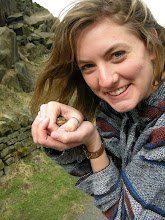Last weekend I traveled to the Shetland Islands. The group was large: the one night we were all in the hostel together there 16 of us? The ferry took us from the Aberdeen harbor to Lerwick overnight (19:30-7:30). I love boats. The rocking sensation of the waves is one of the most soothing things in the world, and it made sleeping on the lounge floor not uncomfortable.
We rented cars and split up based on interest of activity. I really wanted to be able to try driving, but there were no automatic transmission cars available so I had to entrust my life to others, some of whom were competent drivers and some of whom were definitely not. The car was a great freedom. Shetland has a population of 22,000 people, plenty of birds, some ponies, sheep, seals and rabbits. The buses would have been infrequent and likely unreliable.
This was definitely a nature-oriented trip. We went on two walks the first day and one on the second day. Shetland is made up of coasts. It is a treeless island, and while there is habitation in the center, there is not much (there is not much of the center, either, basically anywhere you are is not far from a coast) to see or do there. Shetland and the Orkneys were created by volcanic activity way back in some age or eon, and at a later one they were scraped by receding glaciers. This formation is the source of their spectacular cliffs, rounded hills, and scattering of stones. The lack of trees and lack of animals on the island emphasized the remoteness of the island. Hege would tell me that the Norse god Odin was following us in every raven that we saw, and neither of us would have been surprised had a Viking ship appeared on the horizon or had a hinkypunk tried to lead us into a bog. Birds were the one thing that was plentiful. Besides the pesky seagull, we saw mostly guillemots, gannets, terns and puffins. From far away, gannets (a white bird with yellow heads) sitting on the cliffs and rocks looked like snow ice; it was only the fact that they were diving in the air that could prove otherwise. Puffins fly so haphazardly that it was hard to believe they are airborne creatures; I thought they would just drop out of the sky at some points.
The first day we drove to the southern tip of the islands, where there is a lighthouse built by Robert Stevenson, grandfather of Robert Louis Stevenson (author of Treasure Island), said to have been inspiration to the author. The second day we drove up to the very northern tip of the northern island, Unst. We had to take two ferries to get there, one from the mainland to Yell, and then one to Unst. Unst has a population of 1100 people. It is very remote and besides a lavishly pink bus stop, there are no frills. The landscape is desolate and compelling. I don’t think I could ever live in the Shetlands because the romanticism would overwhelm me.
Now I am back in Aberdeen and have one month left before I fly home. My classes are over and I have two exams, one on the 25th and one on the 1st. I am not too concerned about finding time to study for them. My parents are coming on the 6th to visit and we are going to the Isle of Skye for a few days. I still want to make it to Stonehenge, but we shall see if I pull it off. Besides that, I am very much looking forward to enjoying some time in Aberdeen.
Subscribe to:
Post Comments (Atom)


No comments:
Post a Comment